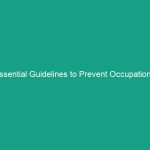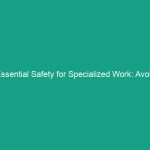Good Morning Team!
Today, we’re here to discuss a critical aspect of our daily work life: taking ownership of Safety in the workplace. This Toolbox Talk is aimed at empowering each of you to actively participate in maintaining a safe working Environment. Let’s dive into why this topic is essential for all of us.
Understanding Ownership of Safety in the Workplace
Taking ownership of safety means that each employee is responsible for their own safety and the safety of their coworkers. This encompasses understanding potential Hazards, adhering to safety protocols, and proactively identifying risks before they escalate. By fostering a culture of safety, we can prevent accidents and create a work environment where everyone feels secure.
Many people mistakenly believe that safety is solely the responsibility of management or the safety department. In reality, every one of us plays a crucial role in ensuring safety. When we take ownership, we contribute to a more productive and harmonious workplace.
Key Hazards, Risks, and Safety Considerations
In any workplace, there are a variety of hazards that can pose risks to our health and safety. Here are a few common hazards that we should be aware of:
- Slips, Trips, and Falls: These are among the most common workplace injuries. Wet floors, cluttered walkways, and uneven surfaces can lead to serious accidents.
- Equipment Safety: Improper usage of machinery can result in severe injuries. Always ensure that you are trained and authorized to use specific equipment.
- Hazardous Materials: Chemicals and other hazardous substances require careful handling. Familiarize yourself with Material Safety Data Sheets (MSDS) and follow all safety protocols.
- Ergonomic Risks: Poor workstation setup can lead to musculoskeletal disorders. Proper posture and ergonomic equipment are essential to prevent strain.
Ignoring safety protocols can lead to real-world consequences, including injuries, lost work time, and increased insurance premiums. In severe cases, neglecting safety can even result in fatalities. Therefore, it’s vital that we remain vigilant and prioritize safety in everything we do.
Best Practices, Procedures, & Actionable Advice
To effectively take ownership of safety, here are some Best Practices that each of you can implement:
- Stay Informed: Keep up-to-date with safety protocols and attend all Training sessions. Knowledge is your first line of defense against hazards.
- Conduct Regular Inspections: Take a few minutes each day to assess your workspace. Look for potential hazards and report them immediately.
- Use Personal Protective Equipment (PPE): Always wear the appropriate PPE for your tasks. This may include helmets, gloves, goggles, or hearing protection.
- Practice Good Housekeeping: A clean workspace is a safe workspace. Ensure that all tools and materials are stored properly and that work areas are free of clutter.
- Communicate Openly: If you notice a safety issue, speak up! Whether it’s to a colleague or a supervisor, communication is key to addressing safety concerns.
Let’s consider a recent incident where a colleague ignored the need for proper lifting techniques. As a result, they suffered a back injury that required weeks of recovery. This situation could have been avoided had they taken ownership of their safety and followed proper Procedures. We must learn from such incidents and commit to implementing Best Practices.
Regulations, Standards, and Compliance
Understanding and complying with safety Regulations is crucial. The Occupational Safety and Health Administration (OSHA) sets forth guidelines to protect workers. Here are some important points to remember:
- Know the Standards: Familiarize yourself with osha standards relevant to your job. This knowledge will help you recognize Safe Practices.
- Regular Training: Participate in mandatory safety training and refresher courses. This ensures that you remain compliant and are aware of any changes in regulations.
- Report Non-Compliance: If you observe unsafe practices or conditions, report them to your supervisor. Compliance is a collective responsibility.
Compliance is not just about following rules; it’s about protecting yourself and your coworkers. When we adhere to safety standards, we foster a culture of safety that Benefits everyone.
Employee Engagement & Discussion
Now, let’s open the floor for discussion. I’d love to hear your thoughts on the following questions:
- What safety challenges have you encountered related to taking ownership of safety?
- Can you share an experience where you or a colleague took proactive steps to enhance safety?
- What suggestions do you have for improving our safety culture?
Engaging in discussions about safety helps us learn from each other and promotes a shared commitment to creating a safer workplace.
Conclusion & Key Takeaways
As we wrap up today’s Toolbox Talk, let’s recap the main points:
- Taking ownership of safety is a collective responsibility.
- Be aware of hazards and actively participate in safety practices.
- Stay informed about regulations and ensure compliance.
- Communicate openly and encourage discussions about safety.
Remember, safety is not just a priority; it is a value that we must uphold every day. By taking ownership, we can create a safer, more productive workplace for everyone. Thank you all for your attention and your commitment to safety. Let’s make it a priority!


